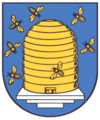Bee (heraldic animal)

In heraldry , the insect bee is a heraldic animal .
As a common figure , it is shown individually or in three passages , i.e. 2: 1 in the coat of arms, but other representations are not excluded. The bee shown in the top view is slightly stylized and the coloring is very often gold or yellow. The bee stands for diligence, zeal for work and order.
Napoleon Bonaparte gave the bee as an award to many cities. The coats of arms of these cities "first order" ( Bonne ville de l'Empire français ; German: Good city of the French empire ) had three bees in the red head of the shield according to Napoleonic heraldry . One of these so distinguished cities was Mainz . During the French period (Napoleonic Empire), many coats of arms were changed by replacing the lilies with the Bonapartian bees, which were basically nothing more than inverted lilies (fleur de lys) .
The coat of arms of wasps in the Magdeburger Börde is talking .
The Pope's coat of arms Urban VIII shows three bees (2: 1) in blue.
Beehive
The beehive , also known as the beehive , is, like the bee, a popular motif in the coat of arms. Both common figures cannot always be separated from one another. It is modeled on the natural basket and is slightly stylized. The entrance hole is directed towards the viewer. Its coloring is mainly gold (yellow), although other colors are possible. It can be represented with or without its inhabitants. The surface is slightly scaled or shown with surrounding rings, but not mentioned in the description. The beehive can also be held by a heraldic figure . Bees, like the beehive in particular, became widespread through the symbolism of the Freemasons . In La Chaux-de-Fonds , since 1851 it has generally stood for the virtue of diligence already mentioned above (see photo glass window Munich) and the emerging industry.
The Mainz wheel with bees
Coat of arms of Bremen as Bonne ville de l'Empire français (1811–1813)
Beehive in the coat of arms of Ebeleben
similar in Frommenhausen
Coat of arms Reinsdorf (Saxony)
Coat of arms Zeillern (Lower Austria)
Borne (Overijssel)
Beehive in the seal of Utah / USA
literature
- David Engels , Carla Nicolaye (Ed.): Ille operum custos. Cultural-historical contributions to the ancient symbolism of bees and their reception (= Spudasmata. Vol. 118). Olms, Hildesheim et al. 2008, ISBN 978-3-487-13606-6 .










